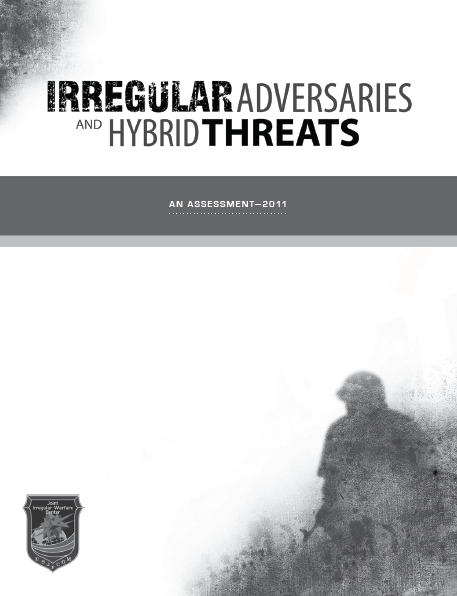U.S. Joint Forces Command Joint Irregular Warfare Center
- 40 pages
- May 2011
- 4.9 MB
To understand irregular warfare’s importance to the United States, it is first necessary to understand who is capable of threatening our national security using irregular means. This assessment discusses three types of groups that conduct their conflict with the United States using such means: insurgent groups, violent extremist organizations, and criminal networks. The descriptions we provide here are not intended to be comprehensive definitions, since such definitions would incorrectly imply a consensus among policymakers, officers, and analysts that simply does not exist. Moreover, the finality such definitions suggest risks fostering intellectual rigidity in conceptualizing and identifying irregular threats and in developing courses of action to mitigate, deter, or defeat such adversaries. Thus, these descriptions are presented only to provide clear terms of reference for the discussion that follows.
Insurgent groups (or insurgencies) are organized movements aimed at the overthrow of or separation from a constituted government or at the attainment of specific rights through the use of subversion and armed conflict. Insurgencies stem from root causes that create popular discontent sufficient to convince citizens to risk their lives in order to achieve the group’s goals. Although it may be possible to identify categories of root causes, such as religious or ethnic discrimination, economic failure, or rampant corruption, insurgencies frequently stem from a combination of causes, and different individuals may join a common insurgent group for different reasons. To ensure strategic and operational unity of effort, insurgent groups tend to be hierarchically structured, and they may evolve into large, armed, and uniformed cadre. As the organizations grow, they begin to require safe havens. Such sanctuaries must be supported by a significant element of the domestic population or at least tolerated by a geographically contiguous state.
Violent extremist organizations are often referred to as terrorist groups. However, because terrorism is a tactic also frequently employed by insurgent groups, this document uses the term violent extremist organizations to distinguish between these organizations and insurgents. Violent extremist organizations seek to strike fear into societies and governments through seemingly random acts of unlawful violence, primarily attacking civilian targets. Unlike insurgent groups, which may include attacks on civilian targets as part of a campaign intended to create instability that undermines the constitutional government’s legitimacy, violent extremist organizations rely on such attacks as their principal means of action. Violent extremist organizations are motivated by political, ethnic, religious, or ideological factors that, unlike those that motivate insurgencies, typically transcend state boundaries and are strong enough to justify repeated mass murder. Additionally, because violent extremist organizations tend to be more focused on operational matters (i.e., on planning and conducting future attacks) than on strategic issues, their structures are frequently more flat and more networked than the hierarchical structures common to insurgencies.
Unlike insurgent groups and violent extremist organizations, criminal networks are not motivated by ideology and do not overtly seek to overthrow existing governments or gain control of state institutions. Instead, these syndicates and gangs are motivated by the relatively simple factor of profit. Consequently, criminal networks use violence in order to commit illegal acts (e.g., illegally seize ships), protect or expand their share of an illicit market, or intimidate civilian populations or police forces to create the space necessary to commit illegal activities.
It is important to recognize that the lines between these three irregular adversaries are not always clearly drawn. As previously noted, insurgent groups sometimes employ terrorism as a tactic to achieve their strategic ends. Some engage in criminal activities in order to fund their guerrilla forces, occasionally coming to find, as did the Revolutionary Armed Forces of Colombia and the Irish Republican Army, that the illegal activities initially pursued to fund the struggle become more important, because they are so profitable, than the original ideological cause. Similarly, violent extremist organizations often finance their operations with the proceeds of criminal activity even if that activity contradicts the group’s ideological goals. For example, violent extremist organizations seeking to impose extremist versions of Islamic ideology have shown little compunction in actively participating in opium production and trafficking despite religious proscriptions against involvement with narcotics. Finally, as demonstrated by the Colombian drug cartels, criminal syndicates will engage in terrorism to intimidate government authorities or will seek an accommodation with an insurgent group to obtain sanctuary. Thus, given the often interchangeable and interdependent nature of these irregular forces, black-and-white definitions may obscure more than they illuminate.
…


